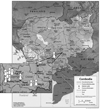Evidence for avian H9N2 influenza virus infections among rural villagers in Cambodia
- PMID: 23537819
- PMCID: PMC3612269
- DOI: 10.1016/j.jiph.2012.11.005
Evidence for avian H9N2 influenza virus infections among rural villagers in Cambodia
Abstract
Background: Southeast Asia remains a critical region for the emergence of novel and/or zoonotic influenza, underscoring the importance of extensive sampling in rural areas where early transmission is most likely to occur.
Methods: In 2008, 800 adult participants from eight sites were enrolled in a prospective population-based study of avian influenza (AI) virus transmission where highly pathogenic avian influenza (HPAI) H5N1 virus had been reported in humans and poultry from 2006 to 2008. From their enrollment sera and questionnaires, we report risk factor findings for serologic evidence of previous infection with 18 AI virus strains.
Results: Serologic assays revealed no evidence of previous infection with 13 different low-pathogenic AI viruses or with HPAI avian-like A/Cambodia/R0404050/2007(H5N1). However, 21 participants had elevated antibodies against avian-like A/Hong Kong/1073/1999(H9N2), validated with a monoclonal antibody blocking ELISA assay specific for avian H9.
Conclusions: Although cross-reaction from antibodies against human influenza viruses cannot be completely excluded, the study data suggest that a number of participants were previously infected with the avian-like A/Hong Kong/1073/1999(H9N2) virus, likely due to as yet unidentified environmental exposures. Prospective data from this cohort will help us better understand the serology of zoonotic influenza infection in a rural cohort in SE Asia.
Copyright © 2013 King Saud Bin Abdulaziz University for Health Sciences. All rights reserved.
Conflict of interest statement
None to declare.
Figures
References
-
- Desvaux S, Sorn S, Holl D, Chavernac D, Goutard F, Thonnat J, et al. HPAI surveillance programme in Cambodia: results and perspectives. Developments in biologicals. 2006;124:211–224. - PubMed
-
- Van Kerkhove MD, Ly S, Holl D, Guitian J, Mangtani P, Ghani AC, et al. Frequency and patterns of contact with domestic poultry and potential risk of H5N1 transmission to humans living in rural Cambodia. Influenza and other respiratory viruses. [Research Support, Non-U.S. Gov't] 2008 Sep;2(5):155–163. - PMC - PubMed
Publication types
MeSH terms
Substances
Grants and funding
LinkOut - more resources
Full Text Sources
Other Literature Sources
Medical


